

Defining Critical Thinking. It entails the examination of those structures or elements of thought implicit in all reasoning: purpose, problem, or question-at-issue; assumptions; concepts; empirical grounding; reasoning leading to conclusions; implications and consequences; objections from alternative viewpoints; and frame of reference.
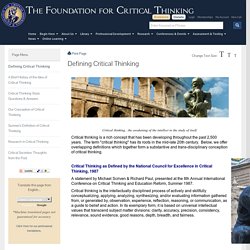
Critical thinking — in being responsive to variable subject matter, issues, and purposes — is incorporated in a family of interwoven modes of thinking, among them: scientific thinking, mathematical thinking, historical thinking, anthropological thinking, economic thinking, moral thinking, and philosophical thinking. Critical thinking can be seen as having two components: 1) a set of information and belief generating and processing skills, and 2) the habit, based on intellectual commitment, of using those skills to guide behavior. Critical thinking varies according to the motivation underlying it.
VispoSec. Index of Abandon the site. Nunc Stans. Anthroposophical Society in America: anthroposophy.org. Haecceity. Haecceity (/hɛkˈsiːɪtɪ/; from the Latin haecceitas, which translates as "thisness") is a term from medieval philosophy first coined by Duns Scotus which denotes the discrete qualities, properties or characteristics of a thing which make it a particular thing.
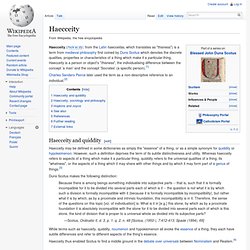
Haecceity is a person or object's "thisness", the individualising difference between the concept 'a man' and the concept 'Socrates' (a specific person).[1] Charles Sanders Peirce later used the term as a non-descriptive reference to an individual.[2] Haecceity and quiddity[edit] Haecceity may be defined in some dictionaries as simply the "essence" of a thing, or as a simple synonym for quiddity or hypokeimenon. However, such a definition deprives the term of its subtle distinctiveness and utility. Duns Scotus makes the following distinction:
Tautology (logic) Is sometimes used to denote an arbitrary tautology, with the dual symbol (falsum) representing an arbitrary contradiction.
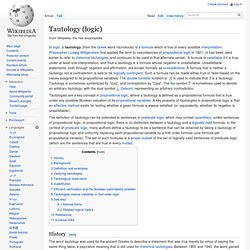
Reflective Equilibrium. First published Mon Apr 28, 2003; substantive revision Wed Jan 12, 2011 Many of us, perhaps all of us, have examined our moral judgments about a particular issue by looking for their coherence with our beliefs about similar cases and our beliefs about a broader range of moral and factual issues.
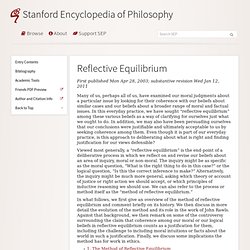
In this everyday practice, we have sought “reflective equilibrium” among these various beliefs as a way of clarifying for ourselves just what we ought to do. In addition, we may also have been persuading ourselves that our conclusions were justifiable and ultimately acceptable to us by seeking coherence among them. Even though it is part of our everyday practice, is this approach to deliberating about what is right and finding justification for our views defensible? Nasreddin.
Jürgen Habermas. Biography[edit] Habermas was born in Düsseldorf, Rhine Province, in 1929.
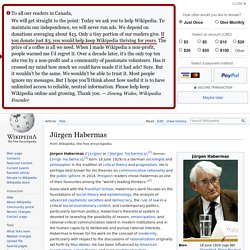
He was born with a cleft palate and had corrective surgery twice during childhood.[4] Habermas argues that his speech disability made him think differently about the importance of communication and prefer writing over the spoken word as a medium.[5] From 1956 on, he studied philosophy and sociology under the critical theorists Max Horkheimer and Theodor Adorno at the Goethe University Frankfurt's Institute for Social Research, but because of a rift between the two over his dissertation—Horkheimer had made unacceptable demands for revision—as well as his own belief that the Frankfurt School had become paralyzed with political skepticism and disdain for modern culture[6]—he finished his habilitation in political science at the University of Marburg under the Marxist Wolfgang Abendroth.
Habermas then returned to his chair at Frankfurt and the directorship of the Institute for Social Research. Zecharia Sitchin. "Nibiru (hypothetical planet)" redirects here.
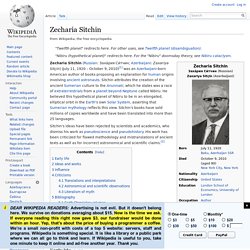
For the "Nibiru" doomsday theory, see Nibiru cataclysm. Zecharia Sitchin (Russian: Заха́рия Си́тчин; Azerbaijani: Zaxariya Sitçin) (July 11, 1920 – October 9, 2010)[1] was an Azerbaijani-born American author of books proposing an explanation for human origins involving ancient astronauts. Sitchin attributes the creation of the ancient Sumerian culture to the Anunnaki, which he states was a race of extraterrestrials from a planet beyond Neptune called Nibiru. He believed this hypothetical planet of Nibiru to be in an elongated, elliptical orbit in the Earth's own Solar System, asserting that Sumerian mythology reflects this view. Sitchin's books have sold millions of copies worldwide and have been translated into more than 25 languages. György Lukács. As a literary critic Lukács was especially influential, because of his theoretical developments of realism and of the novel as a literary genre.
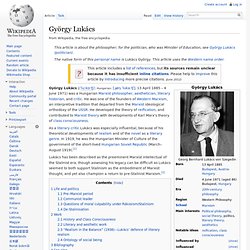
In 1919, he was the Hungarian Minister of Culture of the government of the short-lived Hungarian Soviet Republic (March–August 1919).[1] Lukács has been described as the preeminent Marxist intellectual of the Stalinist era, though assessing his legacy can be difficult as Lukács seemed to both support Stalinism as the embodiment of Marxist thought, and yet also champion a return to pre-Stalinist Marxism.[2] Life and politics[edit] Georg Lukács was born Löwinger György Bernát, in Budapest, Hungary, to the investment banker József Löwinger (later Szegedi Lukács József; 1855–1928) and his wife Adele Wertheimer (Wertheimer Adél; 1860–1917), who were a wealthy Jewish family.
He had a brother and sister. Pre–Marxist period[edit] Communist leader[edit] Lukács in 1919 After the Hungarian Soviet Republic was defeated, Lukács fled from Hungary to Vienna. EpistemeLinks: Philosophy Resources on the Internet. Dimension-Cruncher: Exotic Spheres Earn Mathematician John Milnor an Abel Prize. John Milnor, an American mathematician best known for the discovery of exotic hyperspheres, was awarded the 2011 Abel Prize, the Norwegian Academy of Science and Letters announced March 23.
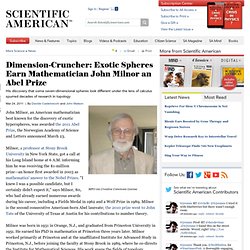
Milnor, a professor at Stony Brook University in New York State, got a call at his Long Island home at 6 A.M. informing him he was receiving the $1-million prize—an honor first awarded in 2003 as mathematics' answer to the Nobel Prizes. "I knew I was a possible candidate, but I certainly didn't expect it," says Milnor, 80, who had already earned numerous awards during his career, including a Fields Medal in 1962 and a Wolf Prize in 1989.
Milnor is the second consecutive American-born Abel laureate; the 2010 prize went to John Tate of the University of Texas at Austin for his contributions to number theory. Milnor was born in 1931 in Orange, N.J., and graduated from Princeton University in 1951. He earned his PhD in mathematics at Princeton three years later. The discovery was somewhat accidental. Emanuel Swedenborg. Emanuel Swedenborg (
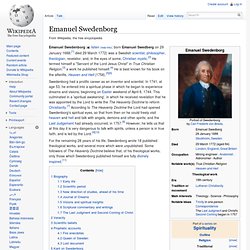
Www.nicolaskaloy.com.